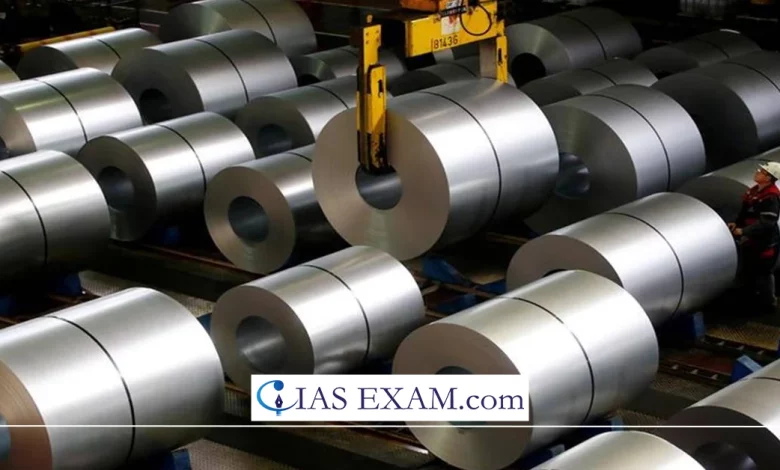
Context
The Steel Ministry is creating a new green steel policy to decrease carbon emissions during the production of steel.
Green Steel
- Green steel is a type of steel production by which the processes have been optimised so as to reduce a carbon footprint and widespread energy dependence on non-renewables.
- In most cases, steel makers produce their own energy from renewable energy sources, use the scrap steel, put into place latest energy-saving technologies and apply carbon capture and storage methods.
- The aim is to transform the steel industry into one that relies less on fossil fuels and natural resources in order to decrease its environmental footprints.
About the Green Steel Policy
- The Government of India has resolved to bring about a path-breaking and substantial change in its methods of producing steel with the formulating of the Green Steel Policy, which is being implemented to align the steel production with environmental sustainability.
- This environmental policy is the proof of India’s strive towards reduction of carbon dioxide release and at the same time this will help industrial companies to follow eco-friendly activities.
- The Ministry of the New and is designated the financial resource for the testing of hydrogen application in steelmaking in terms of a green steel initiative.
- India is making technology subsystems for separating CO2 from its Direct Reduced Iron (DRI) by hydrogen and the pilots of DRI facilities based on hydrogen are under interim investigation.
- The policy represents a set of rules which are aimed at supporting the green steel production that is putting the largest emphasis on the manufacturing processes, the required skills and the necessary financial issues.
Strategic Initiatives
- Decarbonization Efforts: The policy outlines a clear roadmap for the steel industry to adopt low-carbon technologies and reduce greenhouse gas emissions.
- Renewable Energy Integration: A significant focus is placed on harnessing renewable energy sources to power steel manufacturing processes.
- Skill Development: The policy recognizes the need for a skilled workforce adept in green technologies and has established task forces to address this requirement Financial and Technological Aspects.
- Incentivizing Green Investments: The policy explores financial strategies, including incentives and funding options, to encourage investments in green steel technologies.
- Technological Innovations: Emphasis on advanced technologies such as green hydrogen and carbon capture to facilitate the transition to green steel production.
Advantages
- Green steel making processes reduce the carbon emissions by a factor of about 90% as compared to traditional blast furnace method, thus reducing its carbon footprint.
- It also serves the goal of conservation energy by substituting coal and optimised usage of scrap steel.
- Beyond all, sustainable steel substitutes traditional steel in the green building sector and infrastructure improvement brings about the future, which is environmentally friendly.
Disadvantages
- Green steel, which at the present stage is more expensive than traditional steel due to the relatively new technology still being developed, is likely to become cheaper as the technology gradually continues to mature.
- An expensive first phase of development in the advanced technology industry creates a challenge that results in future environmental problems.
- While the Green Steel Policy is geared to blending economics and environmental sustainability for the spread steel industry in the world, adequate policies need to be framed with the local realities to make the policy workable.
- Thus, this scheme also adds, achieving net zero emissions by 2070 target of India.
Green Steel Production In India
- Thirteen task forces were previously created to address different ways of producing green steel.
- Recently, a fourteenth task force was formed to investigate the use of biochar or biomass as alternatives in blast furnace operations to reduce carbon emissions.
- India is also exploring its own pure-hydrogen-based technology for iron production, and a pilot project involving collaboration between steel players and a research lab is being considered.
- This hydrogen-based technology uses hydrogen instead of fossil fuels and produces water as waste.
Conclusion
The Green Steel Policy represents India’s proactive approach to tackling climate change while fostering economic development. It is a significant step towards transforming the steel industry into a more sustainable and environmentally friendly sector.
Source: The Business line
UPSC Mains Practice Question
Q.Discuss the significance of India’s Green Steel Policy and its potential impact on the country’s steel industry and environmental sustainability. Examine the challenges and opportunities associated with the implementation of India’s Green Steel Policy and its role in fostering sustainable development.





.png)



